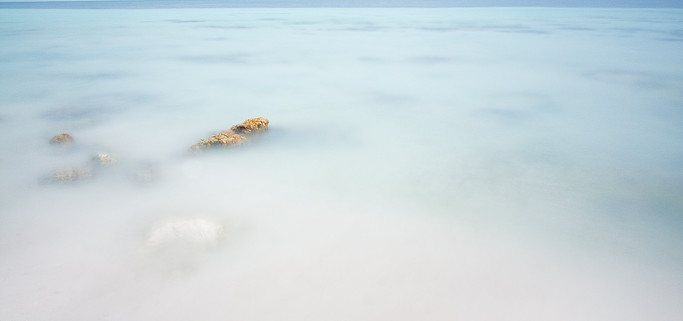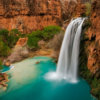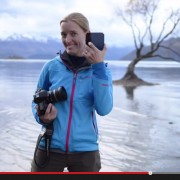Filters and Fieldwork
This shot required very little special post-processing… just setting the correct color balance, and a bit of subtle mid-tone contrast. The real work of creating this particular image happened in the field… well… on the beach, actually. :)
This is a mid-day shot – I took it around 2 pm. Deep blue storm clouds were moving in. The water at Bahia Honda in the Florida Keys is this incredible turquoise or emerald color (depending upon light conditions and how rough the water is) and the sand is smooth and white. I wanted something different for this image. Jay I were playing around with our cameras… and this is the result.
There were a couple of problems with this scene as I stood there. First, the waves weren’t big enough to blur out easily… but they were too small to look good frozen in time. No matter what I did with my camera settings, I wasn’t getting a very interesting image. Second, there were strands of dark seaweed floating in the water. They created distracting streaks in the water, and left my test shots feeling pretty unappealing.
The solution to both problems? A whole lot of Neutral Density Filter. I used my own filter, and also borrowed Jay’s. The filters significantly reduced the amount of light entering the lens – by about ten stops in all. So, in order to get a correct exposure, I had to use a long shutter speed. 10 seconds at f/11 produced exactly the effect I wanted. The waves were completely smoothed out, so that the water seems calm and almost surreal. And all that floating seaweed? Well, it moved around so much with each wave that it blurred itself into oblivion! I didn’t have to clone out a single strand.
Even the clouds are softer – because they shifted during the long exposure. The rock in the foreground provides a clear point of interest, and since it is in clear focus, the scene doesn’t feel too blurred. Sometimes it’s helpful to have a sharp foreground object when you blur an image like this – it helps to anchor the scene.
So – what do you think? Was the technique successful? Does the image work for you?
Have you ever used a Neutral Density Filter? Or a long shutter speed to produce an effect like this? If not – maybe you should try it! It’s kinda fun! :)










Thanks for sharing the technique. Which ND filter you guys use most (brand+stop)? Any recommendations?
HI Vaibhav,
Here are the filters we use: http://www.jaypatelphotography.com/jay
Any brand would work…The key is to produce the images that look like they were produced without using filter. ;))
Thanks Jay!
Great article Varina, thank you for sharing.
You’re welcome, David!
Great post, again!
The issue with using two stacked polarizers (or a VND, from my experience) is the amount of exposure (across the frame) is uneven. On a wide angle lens (in this case, a 24mm), two quadrants of the frame are noticeably darker than the other two. I’ve found that a solid ND filter works better (for my needs). I end up using the full density anyways, so an 6 or darker ND fits the bill. Just my 2 cents:)
Thanks for the comment, David. I see what you mean about the double polarizer setup. Since these filters polarize unevenly, it follows that certain areas would be much darker than others. Especially when you are using a wide-angle lens. Even a single circular polarizer will create uneven polarization with a wide-angle lens. I used to use a CP filter much more often for wide-angle photography – but I often noticed a dark semi-circle in the skies. Now, I rarely use a CP with a wide-angle lens.
Absolutely elegant, Varina! I’ve learned that experimenting and patience are critical components when shooting long exposures (and sometimes it’s hard when you and your tripod are sinking into the sand). I love converting these long exposures to B&W.
http://younglesonphotoblog.wordpress.com/2012/01/16/the-seawall-and-the-pier/
Thanks Barbara! I love converting to black and white, too. The smooth gradients produced by long exposures and moving water can be just incredible in monotone!
I use graduated ND filters all of the time, but I rarely think to pull out the “regular” ND filter. Thanks for the reminder!
Glad to be of service Denise! ;) Have fun with that ND!
I really love the effect. The seaweed at Bahia Honda can get really overwhelming. This is subtle and beautiful. Makes me want to head out there (I live minutes from Bahia Honda State Park) and play around with my camera.
We were really enjoying your sunny weather last week in the Keys, Laura. Now we’re back home, shoveling five inches of snow this morning so that we could get out of the driveway. :) It sure is pretty up here – but I miss the sunshine. I hope you get a chance to photograph Bahia Honda, soon. It’s a fun place to experiment – and if it’s just outside your door, that’s even better!
Lovely shot. Creative way of utilizing the mid day down time of harsh light :)
I love to use ND filters and the silky effects. I even heard that in absence of really high stop (like 8 or 10) , two circular polarizer give more control and with trial & error similar effects can be achieved …
Thanks, Sathya! I haven’t tried using two polarizers. I’ll have to check that out! A polarizer at full effect will reduce the amount of light entering the lens by about two stops. Do keep in mind that a circular polarizer works best at 90 degrees from the sun… so it may not always have the predictable effect that you want.
This is a great post. I often try to capture these type of shots but can never get them to work out even if 4 exposure stops down. I love the idea of using multiple filters.
Thanks for the great idea!!!
Thanks, Tim! :) Good luck with your photos! I hope the technique works for you!